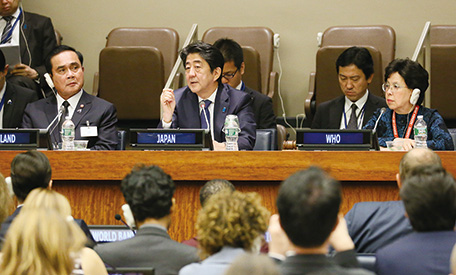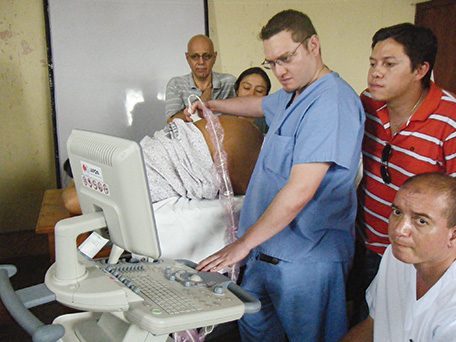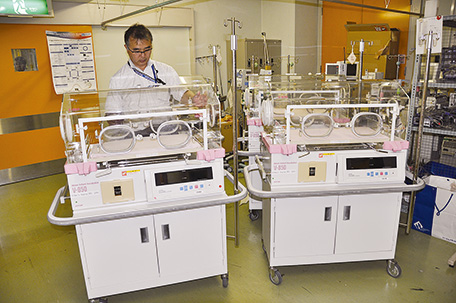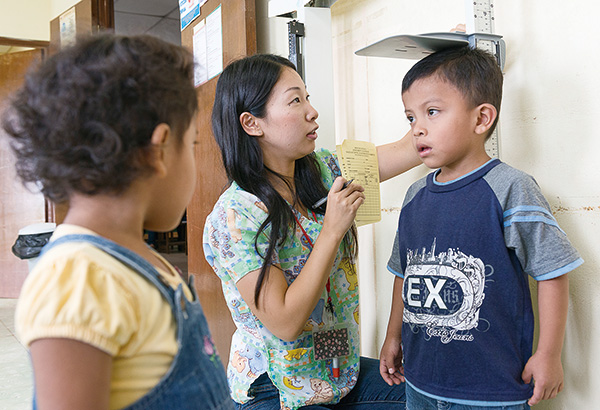1-2 Assistance Necessary to Promote People-centered Development that Supports Basic Human Life
Japan has proactively advocated the concept of “human security” to the international community, a notion that seeks to protect people from widespread and serious threats to the survival, livelihood, and dignity of humans and help them fulfill their abundant potential. There can be no quality growth without “human security.” The following takes a people-centered approach to introducing the dimensions that support basic human life, including health, water, education, and culture.
(1) Health and Population
Many of the people living in developing countries do not have access to the basic health services that are available day-to-day in developed countries. The continued lack of a hygienic environment has led to the annual loss of more than 6.6 million children under the age of five due to infectious diseases, malnutrition, diarrhea, and other ailments.(Note 8) Over 280,000 pregnant women also lose their lives every year, unable to receive emergency obstetric care from skilled birth attendants, including obstetrician, gynecologist, and midwife.(Note 9) Furthermore, due to high rates of population growth, poor countries suffer from further poverty, unemployment, famine, lack of access to and poor quality of education, and environmental deterioration.
To solve these problems, the international community has worked collectively to achieve the following health-related MDGs (MDG 4: reducing child mortality, MDG 5: improving maternal health, and MDG 6: combating HIV/AIDS, malaria, and other diseases) since the year 2000. However, with slow progress, especially in low-income countries, these MDGs expired without being achieved by their deadline (2015). Even in the countries where the indicators improved, low-income families remain unable to access medical services since they cannot afford to pay the healthcare costs. Thus, disparities in health outcomes within a country have emerged as a new challenge.
“Ensure healthy lives and promote well-being for all at all ages” was set under Goal 3 of the SDGs that were agreed as the post-MDGs consisting of 17 goals and 169 targets. In addition, in recent years there is a need for addressing new health issues, for example, malnutrition including over-nutrition, non-communicable diseases such as diabetes and cancer, and aging population.
In order to respond to the increasingly diversified health issues in each country and region in the world, it is important to achieve “universal health coverage (UHC)” to ensure that all people obtain the health services they need without suffering financial hardship when paying for them.
< Japan’s Efforts >
| Health
Japan values global health which ensures human security, and Japan has led international discussions on health system* strengthening, giving priority to health initiatives. At the G8 Kyushu-Okinawa Summit in 2000, infectious diseases were taken up for the first time as a major agenda of the Summit. This led to the establishment of the Global Fund to Fight AIDS, Tuberculosis and Malaria (the Global Fund) in 2002.
At the G8 Hokkaido Toyako Summit in July 2008, the Toyako Framework for Action on Global Health was released by the G8 nations, advocating the importance of health system strengthening. Moreover, at the G8 Muskoka Summit (Canada) in June 2010, the Muskoka Initiative which aims to strengthen support for maternal and child health was launched and Japan announced that it would additionally provide up to ¥50 billion, or approximately $500 million, over the five years from 2011.
Japan presented the Global Health Policy 2011-2015 at the UN Summit on the MDGs in September 2010, and Japan committed $5 billion (including contribution of up to $800 million to the Global Fund in the coming years from 2011), to contribute to the achievement of the health-related MDGs. The three pillars of the Global Health Policy 2011-2015 are: (i) maternal and child health; (ii) measures against the three major infectious diseases* (HIV/AIDS, tuberculosis, and malaria); and (iii) public health emergencies including polio and pandemic influenza. In addition, in May 2013, Japan formulated the Strategy on Global Health Diplomacy. This strategy positioned providing solutions to global health as a priority of Japan’s diplomacy, and it set forth policies to improve global health through joint efforts by the public and private sectors. At TICAD V in June 2013, Prime Minister Shinzo Abe announced this strategy in the opening speech in which he stated that improving the health of all people is indispensable to realize human security, and expressed Japan’s determination to contribute to the promotion of UHC through which all people of the world can receive basic health care services. It was also announced that Japan will provide ¥50 billion and provide support to train 120,000 people in the field of health in the next five years (see this for more information on “Promotion of Universal Health Coverage, and Infectious Diseases Control”).
In September 2015, the Government of Japan approved the Basic Design for Peace and Health, which is the global health policy under the Development Cooperation Charter established in February. This policy aims to draw on Japan’s expertise, technologies, medical equipment, and services to: (i) build a system to respond to public health emergencies such as the Ebola virus disease; and (ii) establish basic health services to all people throughout their course of life. These efforts will be important also for the pursuit of the health goals identified in the UN’s new goals, the 2030 Agenda for Sustainable Development. In September 2015, the Government of Japan established the Basic Guideline for Strengthening Measures on Emerging Infectious Diseases. The guideline presents the direction and priority actions for the next five years, in order to strengthen the measures against infectious diseases that could become global threats.
On the occasion of the 70th UN General Assembly session in September 2015, Prime Minister Abe addressed the side event, The Path towards Universal Health Coverage, which the Japanese government co-organized with the Global Fund and other partners. The Prime Minister stated that based on the Basic Guidelines, it was important that the international community strengthens its capacity to respond to public health emergencies such as the Ebola virus outbreak, and that each country achieve UHC so that they can respond to diverse health problems. Prime Minister Abe addressed at the opening session of Universal Health Coverage in the New Development Era: Toward Building Resilient and Sustainable Health Systems,(Note 10) an international conference co-organized by the Ministry of Foreign Affairs (MOFA) and other organizations in December 2015. In his address, the Prime Minister stated that through the G7 Ise-Shima Summit and TICAD VI, Japan would take the lead in strengthening responses to public health emergencies, promoting UHC, and strengthening health systems.

Prime Minister Shinzo Abe speaks at the “The Path towards Universal Health Coverage (UHC)” held as a side event of the 70th UN General Assembly on September 29, 2015. (Photo: Cabinet Public Relations Office)
For more than 50 years, Japan has been providing a national health insurance system and has become a society in which people enjoy the longest healthy life in the world. Under the new guidelines, Japan will continue to pursue the effective implementation of bilateral assistance, strategic collaborations with global initiatives of international organizations, the enhancement of domestic capabilities and the fostering of human resources.
As for other efforts, in October 2014, the MHLW held the 12th ASEAN and Japan High Level Officials Meeting on Caring Societies, inviting social welfare and health and sanitation policy officials and others from ten ASEAN member states. Under the theme, “Resilient Communities for Active Aging,” the meeting focused on the relationship between aging and communities. Discussion took place on enhancing health and welfare systems in communities, and building cities that are elderly friendly. Discussion also took place on strengthening ASEAN’s measures for coping with aging populations and international cooperation.
- *Universal Health Coverage (UHC)
- UHC ensures all people have access to the basic health services they need without suffering from financial hardship (see this for more information).
- *Health system
- Health system includes establishing mechanisms for governance, the improvement of healthcare facilities, the optimization of the supply of pharmaceuticals, the accurate measurement and effective utilization of healthcare information, financial allocation and administration, resource mobilization as well as the development and management of personnel to operate these processes and provide services.
- *The three major infectious diseases
- The three major infectious diseases refer to HIV/AIDS, tuberculosis, and malaria. Worldwide deaths from these diseases total approximately 3.6 million. The spread of these infectious diseases significantly impacts society and the economy, and is a factor that hampers national development. Accordingly, it is a serious threat to human security, and a global issue that must be addressed by the unified efforts of the international community (see this for more information on infectious diseases).
- Note 8: Source: UN, “The Millennium Development Goals Report 2014”
- Note 9: Source: WHO, UNICEF, UNFPA, and the World Bank, “Trends in Maternal Mortality: 1990 to 2010”
- Note 10: Universal Health Coverage in the New Development Era: Toward Building Resilient and Sustainable Health Systems, held in Tokyo on December 16, 2015, was co-organized by MOFA, the Japan Center for International Exchange, the Ministry of Finance (MOF), the Ministry of Health, Labour and Welfare (MHLW), and JICA. Approximately 300 people, including government officials from various countries, representatives of international organizations, and private-sector experts, attended and held discussions.
Guatemala
Project for Maternal and Child Health in Quetzaltenango, Totonicapan, and Solola in the Republic of Guatemala
Technical Cooperation (March 2011 – March 2015)

Training on use of equipment. (Hospital Nacional de Coatepeque, Quetzaltenango Department). (Photo: JICA)
Guatemala has lagged behind other Central American countries in terms of improving its health indicators. The country’s maternal and infant mortality rate is also higher than surrounding countries, and this trend is particularly evident in Western Guatemala which has a large population of indigenous peoples. The maternal mortality rate was 120 deaths per 100,000 births and the mortality rate among infants (between birth and exactly five years of age) was between 15 and 32 deaths per 1,000 births in 2010.
The reason behind this is that most births are delivered by traditional midwives who do not undergo official medical training, and the only place that people can receive medical care outside of urban areas is community health centers run by the Ministry of Public Health and Social Assistance, which often lack quality services.
Based on the request of the Government of Guatemala, the Government of Japan has been carrying out the Children’s Health Project in the Department of Quetzaltenango covering six municipalities in Quetzaltenango Department since 2005, helping to improve the quality of maternal and child health services locally.
The Project for Maternal and Child Health in Quetzaltenango, Totonicapan, and Solola was initiated in 2011, covering the departments of Totonicapan and Solola, in addition to Quetzaltenango. This project has helped build the capacity of medical personnel involved in maternal and infant care at medical facilities, improved the administrative functions of the Ministry of Public Health and Social Assistance and its regional offices, and spread knowledge for improving the health of mothers and children among the local population.
After providing medical personnel with training on six areas including medical exams for expectant mothers, nutrition management, and low birthweight babies, thorough follow-up efforts were also made. For example, video-based teaching materials (obstetric care, maternal nutrition, newborn care, and infant nutrition) were distributed to health centers for use in their waiting rooms, thereby building capacity further and ensuring the provision of higher quality services. Classes were held where games were used to teach mothers about indications of danger to infants or expectant mothers and how to address these issues. This successfully conveyed knowledge to the local community in a format that was well accepted by the conservative culture.
These efforts spread knowledge about pregnancy and childbirth among women, shed light on family planning and what to watch out for during pregnancy, and raised interest in infant nutrition. At the same time, the provision of necessary medical equipment and attempts to improve maternal and child data gathering and analysis capabilities at medical facilities were successful, leading to greater social collaboration between mothers, medical officials and midwives. As a result, the maternal mortality rate in each department was reduced by between 24% and 34% from 2010 to 2013.
This collaboration and initiative involving Japanese experts, Guatemalan medical personnel and mothers is effectively saving the lives of mothers and children.
Malawi
Child Friendly Community Health Project
JICA Partnership Program (Partner Type) (May 2013 – Ongoing)

Mr. Yamazaki of ISAPH prepares infant incubators for shipment. (Photo: ISAPH)
Children in Mzimba District and its surrounding areas in Northern Malawi suffer from various forms of malnutrition. Studies have shown that this is caused by a lack of adequate food consumption resulting from local eating habits and poor nutritional balance.
Although various types of food are available at markets in this region, mothers lack sufficient knowledge about proper complementary foods and how to ensure their children receive the necessary nutritional balance. The resulting malnutrition is also one of the causes of parasitic diseases and diarrhea.
In light of this, International Support and Partnership for Health (ISAPH), an NPO affiliated with St. Mary’s Hospital in Kurume City, Fukuoka Prefecture, participated in a JICA Partnership Program (JPP)*1 to build capacity among health workers at the Mzimba District Health Office. This initiative also involved educating local residents about three areas of health and medicine: improving infant nutrition, preventing diseases detrimental to nutrition intake, and primary medical care to address these diseases.
ISAPH has engaged in activities to improve the health of villagers in this region, and now it has decided to more actively improve the nutrition of infants through education for local residents. ISAPH officials visited the villages of Mzimba District and they found that the frequency of breast-feeding was low, and that infants under six months of age with undeveloped gastrointestinal organs were not provided appropriate complementary foods with a good nutritional balance.
Based on this, they set up groups of mothers in the region to teach others how to make nutritionally-balanced complementary foods and share this information with others. Also, they worked to educate villagers about the importance of preventing childhood diseases and receiving treatment in the event a child were to fall ill.
Integrated problem-solving approaches have now begun in Malawi with the assistance of this Japanese NGO to improve children’s health and raise greater awareness about nutrition and disease not only among families, but among villagers and local governments as well. (As of August 2015)
*1: For more information, see Glossary.

A Japan Overseas Cooperation Volunteer (nutritionist), Ms. Mio Maedera is dispatched to the Ministry of Health, Regional office of Veraguas in central Panama, where she regularly visits medical centers in the mountain areas of the province to examine the nutritional status of local people, particularly children, and to provide necessary guidance in order to improve nutrition. (Photo: Maximo Novas)
